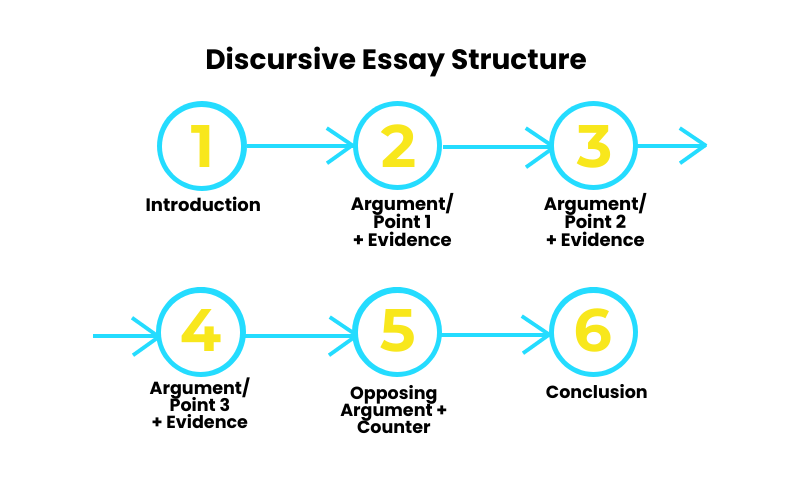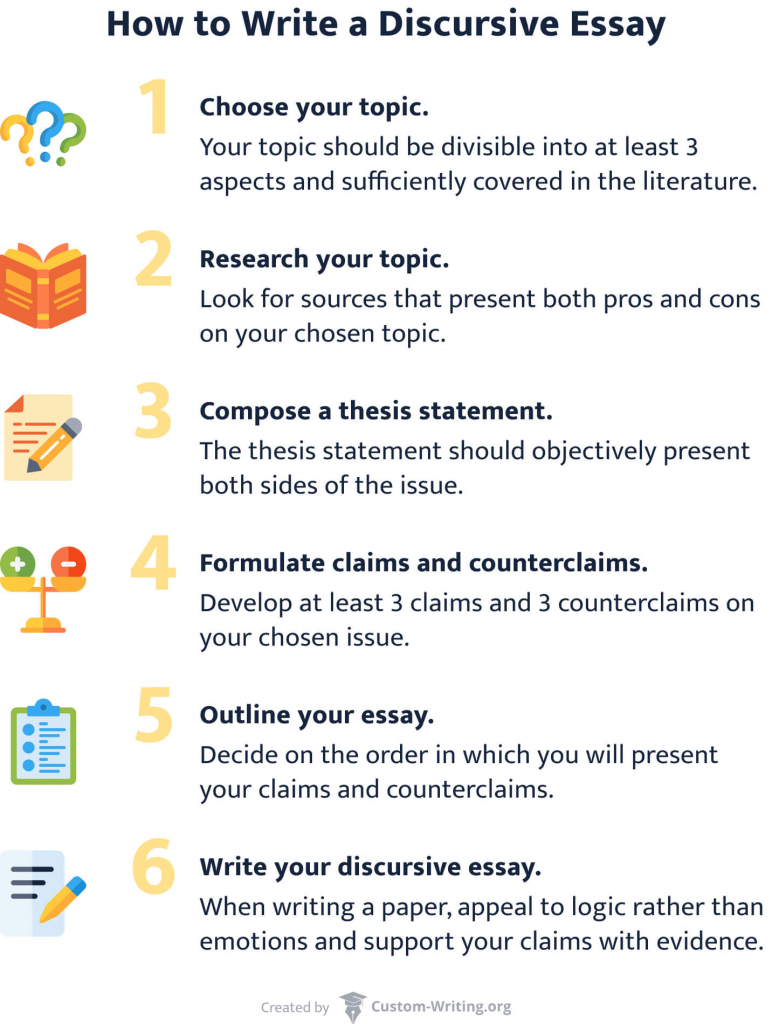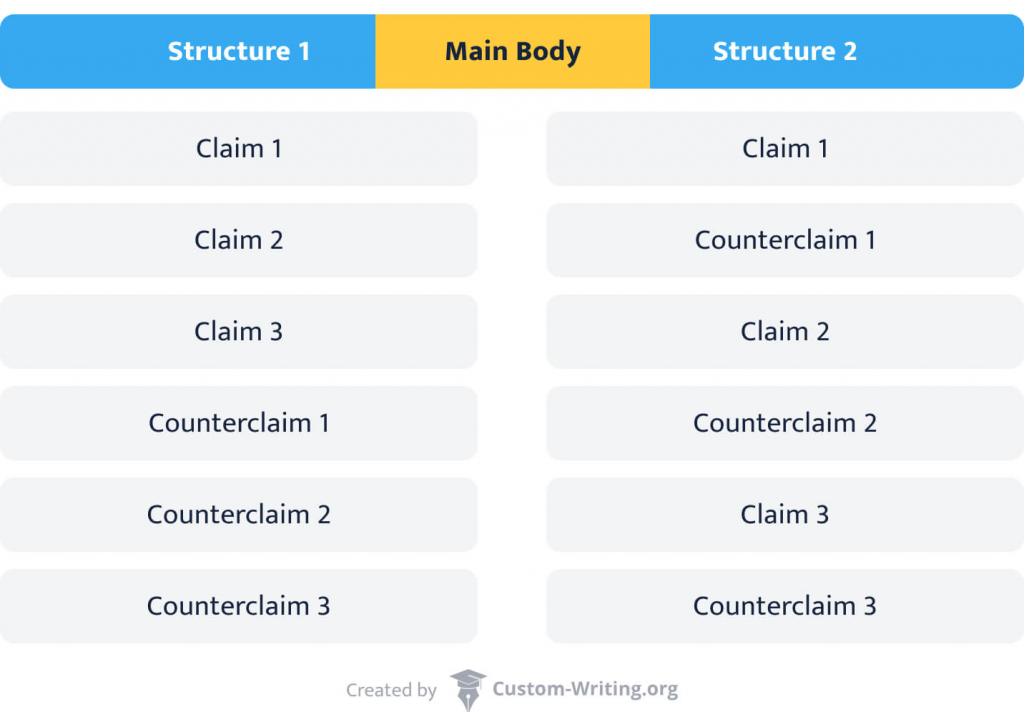

26 Planning a Discursive Essay
Discursive essay – description.
A discursive essay is a form of critical essay that attempts to provide the reader with a balanced argument on a topic, supported by evidence. It requires critical thinking, as well as sound and valid arguments (see Chapter 25) that acknowledge and analyse arguments both for and against any given topic, plus discursive essay writing appeals to reason, not emotions or opinions. While it may draw some tentative conclusions, based on evidence, the main aim of a discursive essay is to inform the reader of the key arguments and allow them to arrive at their own conclusion.
The writer needs to research the topic thoroughly to present more than one perspective and should check their own biases and assumptions through critical reflection (see Chapter 30).
Unlike persuasive writing, the writer does not need to have knowledge of the audience, though should write using academic tone and language (see Chapter 20).
Choose Your Topic Carefully
A basic guide to choosing an assignment topic is available in Chapter 23, however choosing a topic for a discursive essay means considering more than one perspective. Not only do you need to find information about the topic via academic sources, you need to be able to construct a worthwhile discussion, moving from idea to idea. Therefore, more forward planning is required. The following are decisions that need to be considered when choosing a discursive essay topic:
- These will become the controlling ideas for your three body paragraphs (some essays may require more). Each controlling idea will need arguments both for and against.
- For example, if my topic is “renewable energy” and my three main (controlling) ideas are “cost”, “storage”, “environmental impact”, then I will need to consider arguments both for and against each of these three concepts. I will also need to have good academic sources with examples or evidence to support my claim and counter claim for each controlling idea (More about this in Chapter 27).
- Am I able to write a thesis statement about this topic based on the available research? In other words, do my own ideas align with the available research, or am I going to be struggling to support my own ideas due to a lack of academic sources or research? You need to be smart about your topic choice. Do not make it harder than it has to be. Writing a discursive essay is challenging enough without struggling to find appropriate sources.
- For example, perhaps I find a great academic journal article about the uptake of solar panel installation in suburban Australia and how this household decision is cost-effective long-term, locally stored, and has minimal, even beneficial environmental impact due to the lowering of carbon emissions. Seems too good to be true, yet it is perfect for my assignment. I would have to then find arguments AGAINST everything in the article that supports transitioning suburbs to solar power. I would have to challenge the cost-effectiveness, the storage, and the environmental impact study. Now, all of a sudden my task just became much more challenging.
- There may be vast numbers of journal articles written about your topic, but consider how relevant they may be to your tentative thesis statement. It takes a great deal of time to search for appropriate academic sources. Do you have a good internet connection at home or will you need to spend some quality time at the library? Setting time aside to complete your essay research is crucial for success.
It is only through complete forward planning about the shape and content of your essay that you may be able to choose the topic that best suits your interests, academic ability and time management. Consider how you will approach the overall project, not only the next step.
Research Your Topic
When completing a library search for online peer reviewed journal articles, do not forget to use Boolean Operators to refine or narrow your search field. Standard Boolean Operators are (capitalized) AND, OR and NOT. While using OR will expand your search, AND and NOT will reduce the scope of your search. For example, if I want information on ageism and care giving, but I only want it to relate to the elderly, I might use the following to search a database: ageism AND care NOT children. Remember to keep track of your search strings (like the one just used) and then you’ll know what worked and what didn’t as you come and go from your academic research.
The UQ Library provides an excellent step-by-step guide to searching databases:
Searching in databases – Library – University of Queensland (uq.edu.au)
Did you know that you can also link the UQ Library to Google Scholar? This link tells you how:
Google Scholar – Library – University of Queensland (uq.edu.au)
Write the Thesis Statement
The concept of a thesis statement was introduced in Chapter 21. The information below relates specifically to a discursive essay thesis statement.
As noted in the introduction to this chapter, the discursive essay should not take a stance and therefore the thesis statement must also impartially indicate more than one perspective. The goal is to present both sides of an argument equally and allow the reader to make an informed and well-reasoned choice after providing supporting evidence for each side of the argument.
Sample thesis statements: Solar energy is a cost -effective solution to burning fossil fuels for electricity , however lower income families cannot afford the installation costs .
Some studies indicate that teacher comments written in red may have no effect on students’ emotions , however other studies suggest that seeing red ink on papers could cause some students unnecessary stress. [1]
According to social justice principles, education should be available to all , yet historically, the intellectually and physically impaired may have been exempt from participation due to their supposed inability to learn. [2]
This is where your pros and cons list comes into play. For each pro, or positive statement you make, about your topic, create an equivalent con, or negative statement and this will enable you to arrive at two opposing assertions – the claim and counter claim.
While there may be multiple arguments or perspectives related to your essay topic, it is important that you match each claim with a counter-claim. This applies to the thesis statement and each supporting argument within the body paragraphs of the essay.
It is not just a matter of agreeing or disagreeing. A neutral tone is crucial. Do not include positive or negative leading statements, such as “It is undeniable that…” or “One should not accept the view that…”. You are NOT attempting to persuade the reader to choose one viewpoint over another.
Leading statements / language will be discussed further, in class, within term three of the Academic English course.
Thesis Structure:
- Note the two sides (indicated in green and orange)
- Note the use of tentative language: “Some studies”, “may have”, “could cause”, “some students”
- As the thesis is yet to be discussed in-depth, and you are not an expert in the field, do not use definitive language
- The statement is also one sentence, with a “pivot point” in the middle, with a comma and signposting to indicate a contradictory perspective (in black). Other examples include, nevertheless, though, although, regardless, yet, albeit. DO NOT use the word “but” as it lacks academic tone. Some signposts (e.g., although, though, while) may be placed at the start of the two clauses rather than in the middle – just remember the comma, for example, “While some studies suggest solar energy is cost-effective, other critical research questions its affordability.”
- Also note that it is based on preliminary research and not opinion: “some studies”, “other studies”, “according to social justice principles”, “critical research”.
Claims and Counter Claims
NOTE: Please do not confuse the words ‘claim’ and ‘counter-claim’ with moral or value judgements about right/wrong, good/bad, successful/unsuccessful, or the like. The term ‘claim’ simply refers to the first position or argument you put forward (whether for or against), and ‘counter-claim’ is the alternate position or argument.
In a discursive essay the goal is to present both sides equally and then draw some tentative conclusions based on the evidence presented.
- To formulate your claims and counter claims, write a list of pros and cons.
- For each pro there should be a corresponding con.
- Three sets of pros and cons will be required for your discursive essay. One set for each body paragraph. These become your claims and counter claims.
- For a longer essay, you would need further claims and counter claims.
- Some instructors prefer students to keep the pros and cons in the same order across the body paragraphs. Each paragraph would then have a pro followed by a con or else a con followed by a pro. The order should align with your thesis; if the thesis gives a pro view of the topic followed by a negative view (con) then the paragraphs should also start with the pro and follow with the con, or else vice versa. If not aligned and consistent, the reader may easily become confused as the argument proceeds. Ask your teacher if this is a requirement for your assessment.

Use previous chapters to explore your chosen topic through concept mapping (Chapter 18) and essay outlining (Chapter 19), with one variance; you must include your proposed claims and counter claims in your proposed paragraph structures. What follows is a generic model for a discursive essay. The following Chapter 27 will examine this in further details.
Sample Discursive Essay Outline
The paragraphs are continuous; the dot-points are only meant to indicate content.
Introduction
- Thesis statement
- Essay outline (including 3 controlling ideas)
Body Paragraphs X 3 (Elaboration and evidence will be more than one sentence, though the topic, claim and counter claim should be succinct)
- T opic sentence, including 1/3 controlling ideas (the topic remains the same throughout the entire essay; it is the controlling idea that changes)
- A claim/assertion about the controlling idea
- E laboration – more information about the claim
- E vidence -academic research (Don’t forget to tell the reader how / why the evidence supports the claim. Be explicit in your E valuation rather than assuming the connection is obvious to the reader)
- A counter claim (remember it must be COUNTER to the claim you made, not about something different)
- E laboration – more information about the counter claim
- E vidence – academic research (Don’t forget to tell the reader how / why the evidence supports the claim. Be explicit in your E valuation rather than assuming the connection is obvious to the reader)
- Concluding sentence – L inks back to the topic and/or the next controlling idea in the following paragraph
Mirror the introduction. The essay outline should have stated the plan for the essay – “This essay will discuss…”, therefore the conclusion should identify that this has been fulfilled, “This essay has discussed…”, plus summarise the controlling ideas and key arguments. ONLY draw tentative conclusions BOTH for and against, allowing the reader to make up their own mind about the topic. Also remember to re-state the thesis in the conclusion. If it is part of the marking criteria, you should also include a recommendation or prediction about the future use or cost/benefit of the chosen topic/concept.
A word of warning, many students fall into the generic realm of stating that there should be further research on their topic or in the field of study. This is a gross statement of the obvious as all academia is ongoing. Try to be more practical with your recommendations and also think about who would instigate them and where the funding might come from.
This chapter gives an overview of what a discursive essay is and a few things to consider when choosing your topic. It also provides a generic outline for a discursive essay structure. The following chapter examines the structure in further detail.
- Inez, S. M. (2018, September 10). What is a discursive essay, and how do you write a good one? Kibin. ↵
- Hale, A., & Basides, H. (2013). The keys to academic English. Palgrave ↵
researched, reliable, written by academics and published by reputable publishers; often, but not always peer reviewed
assertion, maintain as fact
The term ‘claim’ simply refers to the first position or argument you put forward (whether for or against), and ‘counter-claim’ is the alternate position or argument.
Academic Writing Skills Copyright © 2021 by Patricia Williamson is licensed under a Creative Commons Attribution-NonCommercial-ShareAlike 4.0 International License , except where otherwise noted.
Share This Book
How to Write a Discursive Essay: Format, Tips, & Examples
So, you need to accomplish your discursive essay writing. The typical questions most students ask are: How do you write it? What is discursive essay?
A discursive essay is an academic paper that involves a discussion on a particular topic. It is usually assigned to college students. You may be required to write a paper wherein you have to do one of the following:
- argue for the issue or against it;
- present your points of view on both sides;
- provide your unprejudiced opinion on that matter.
Don’t panic!
Check out the tips from Custom-writing.org experts below. They will assist you in discursive writing and encourage you to examine essay examples. Moreover, in this article, you’ll also learn about different types of discursive essay, and its introduction, main body, and conclusion structure.
- ❓ Discursive Essay Definition
- 🏁 Types of a Discursive Essay
📑 Discursive Essay Format
- ✍️ Writing Guide
- 👍 Do’s and Don’ts
- 📃 Essay Examples
🔗 References
❓ what is a discursive essay.
First of all, let’s figure out what the discursive essay is.
You may think it’s similar to the argumentative essay. It is, but there’s a difference between them in terms of purpose:
- Discursive essays aim to provide a reliable and unbiased assessment of an issue. They don’t have to be completely neutral. Instead, you should write them using the facts and research reports to present both sides of the issue.
- Argumentative essays aim to persuade the reader in your position. This essay requires you to convince as well as educate the reader. The result should be less passionate and more concise than that of a persuasive essay.
And here’s how they differ regarding structure.
Discursive essay structure:
- Start with an introduction to the topic.
- Discuss each essay question in a single paragraph.
- Begin each paragraph with a powerful issue sentence.
- Paragraphs with one point usually followed by a counterpoint paragraph.
Argumentative essay structure:
- Craft a precise thesis statement with your position in the introduction.
- Elaborate on it in the body paragraph, explaining why you’re right.
- Restate and develop your thesis in the conclusion.
- Persuade your reader to agree with your position.
We will take a detailed look at how to structure a discursive essay later, and now let’s find out what are the types of this assignment.
Keep reading!
🏁 Discursive Essay: Main Types
You have to think more critically and more in-depth when reviewing all viewpoints and aspects of discursive writing. Check these three main types of essay writing:
- Opinion Essay requires the author’s opinion on an issue which is stated in the introductory paragraph. It should be clearly presented and followed by reasons and supporting examples. Also, this essay paper should contain an opposing argument that comes before the conclusion. The writer must explain to readers why the mentioned argument is considered to be unconvincing. The writer’s opinion should be restated/summarized in the conclusion.
- For and Against Essay provides readers with a thorough debate on the topic with the help of opposing points of view. Each point should be discussed objectively and described in details. The introductory paragraph puts the issue under consideration. The main body of this essay paper should present examples, reasons, and arguments supported by justifications. The author’s own opinion with balanced reflections on the topic should be stated only in conclusion.
- Essay Suggesting Solution to a Problem discusses problems and finds the main solutions. The introduction paragraph explicitly declares a problem and analyses its causes and consequences. The main body of the essay should offer some suggestions for a possible solution to the problem and potential state consequences or expected results. In conclusion, author’s opinion should be distinctly summarized.
Well, it’s time to talk about the structure of a discursive essay. Like most of the assignments, a discursive paper starts with an introduction and ends with a conclusion:

Introduction
The first question you may ask is how to start a discursive essay introduction. Simple!
- Give your readers a hook – something that would sound interesting to them.
- Provide a short explanation of the problem. You may use quotations, as well as rhetorical questions.
- Show your readers both sides of the arguments and sum up.
You may be wondering…
Is there something I should avoid in my discursive essay introduction?
Yes. No stereotypes and generalizations, please!
The next step under formal essay writing you should take is to compose the body.

There are a few points you should remember:
- First and foremost: stay unprejudiced . Assess all of the aspects of an issue. Leave your feelings behind or for another essay type.
- Second: build your argumentation . If you have several arguments for your viewpoint—provide them in separate paragraphs. This will help you to keep your essay comprehensible and distinct. Don’t forget to submit supporting evidence.
- Third: write the body of an essay in an alternate manner. What does it mean? If your first paragraph supports the paper’s argument, then in the second paragraph you should write something in the opposite of it. Such a combination of supporting and opposite paragraphs will make your essay look apparent, and well researched. Besides, it will help you to remain neutral.
- Fourth: include topic sentences and evidence . Write a summary of the argument at the beginning of the paragraph. It will allow the reader to easier understand what the paragraph is about. Provide evidence to show that you’re not making the facts up.
Well, you’ve almost finished your writing. Now you should focus on the last section. Keep reading, and you will learn how to write a conclusion for a discursive essay.
- In the last section, you should summarize your article including the main points, specified in the body paragraphs.
- You may also logically express your opinion. Remember: it should resonate with your evidence stated in the body paragraphs.
- Don’t repeat findings, just summarize them.
Keep it short. Your conclusion length should not exceed one paragraph.
✍️ How to Write a Discursive Essay
Now that you’re familiar with the discursive essay format, you’re well-equipped to craft your paper. Simply follow this comprehensive step-by-step guide filled with valuable tips.

1. Choose Your Topic
Selecting an effective topic for your discursive essay is a key step that governs the entire writing process. Here are actionable tips to help you with this:
- The topic should be divisible into at least 3 aspects. This allows for analyzing different perspectives and crafting a well-rounded overview. For example, animal testing has aspects like effectiveness, alternatives, and morality.
- The topic should be sufficiently covered in academic literature. This will provide you with a solid foundation of research and facts to support your arguments. Before finalizing a topic, check that ample information exists on it.
- Claims and counterclaims on the topic should be about the same idea. For example, If the claim is that animal testing effectively enables drug development, the counterclaim could be that differences between species limit the usefulness of animal testing data. Both claims center on the efficacy of animal testing.
2. Research Your Topic
Before writing, research your topic thoroughly to gather pertinent information and evidence. Seek out sources that reinforce and dispute your stance, including academic journals, literature, reputable internet sites, news reports, and expert perspectives.
The most effective approach to discover reliable scholarly sources is exploring your university library or repositories. In this case, you can narrow your search field by applying Boolean operators : AND, OR, and NOT.
- Use AND to find articles that contain both search terms. For instance, looking for “canines AND felines” will display articles referencing both.
- Use OR to find articles that contain either of the search terms. For example, searching for “canines OR felines” will produce articles mentioning one or both.
- Use NOT to exclude specific terms from your search results. Searching for “canines NOT felines” will retrieve articles covering canines only.
3. Compose a Thesis Statement
The next step is to develop your thesis statement: a clear and concise declaration of your main argument.
Here are the key qualities of an effective thesis:
- Two-sided. It presents two sides of the issue rather than being biased and one-sided.
- Written in tentative language. Tentative words and phrases display some uncertainty or caution when presenting the discussion. This helps communicate openness to varied perspectives. Phrases such as “it could be argued” and “there is evidence to suggest” can introduce the thesis in a more nuanced manner.
- Based on research, not just opinion. The thesis gains conviction when it includes research findings, statistics, expert views, and other reliable sources.
4. Formulate Claims and Counterclaims
Before you can start planning your essay structure, it is important to develop clear claims and counterclaims that are connected to each other. Claims constitute the main arguments in support of your thesis statement, while counterclaims present opposing viewpoints that challenge your claims.
For a 1000-word discursive essay, having 3 pros (claims) and 3 cons (counterclaims) is generally sufficient to provide a balanced discussion of the topic, but longer essays may require more arguments.
5. Outline Your Essay
Like any other academic work, a discursive paper consists of an introduction, a main body, and a conclusion. Let’s focus on structuring body paragraphs since this can be the most challenging part for students.
One strategy to structure the main body of a discursive essay goes like this:
- Present all the claims favoring your chosen issue.
- Follow up with counterclaims that challenge or give alternative viewpoints on those arguments.
Another potent strategy is to present a claim and its connected counterclaim within the same paragraph. This method lets you directly contrast different perspectives on one aspect of the topic.

If you need help outlining your essay, try our free essay outline generator .
6. Write Your Discursive Essay
When writing a discursive essay, remember to appeal to logic rather than emotions. It means presenting well-reasoned arguments supported by facts rather than relying on feelings.
It’s common to include in-text citations to support your claims. By citing reputable sources, you will provide evidence and authority to your points, making your essay more credible and persuasive.
When including in-text citations, follow the appropriate citation style (such as APA, MLA, or Chicago) and provide a full reference list at the end of your essay to acknowledge the sources you have used.
👍 Discursive Writing Do’s and Don’ts
Do you want more discursive essay writing tips? Fine! Just check them below:
Basic Do’s of a Discursive Essay
- Write in formal, impersonal style
- Use topic sentences
- Give examples for each point
- Use sequencing and linking words
- Identify used sources
- Follow proper citation style
Basic Don’Ts of a Discursive Essay
- Don’t use contractions
- Don’t use overly emotional language
- Don’t use over-generalizations
- Don’t insist on your opinion
- Don’t use personal examples
Well, now you know what discursive essay means, what are its main types, and how to structure it.

Discursive Essay Topics
- Discussion of risk factors that impact human health.
- Discuss the necessity of understanding cultural heritage to provide efficient health care.
- Analyze different opinions on withdrawing patients’ treatment.
- Examine different views on the Civil War.
- Discuss what hostile emotional states are and how they impact human life.
- Discuss the meaning of metaphors used by Virgil in Aeneid .
- Describe different opinions on telehealth in nursing homes.
- The ethicality of stem cell technology.
- Explore the effectiveness of motivational interviewing.
- Discuss how people present themselves online .
- Discuss the reasons for Coca-Cola’s marketing success.
- Analyze the food safety issues and the ways to improve the situation.
- Examine the essential meaning of sleep for people’s physical and mental health.
- Explore various complications of working with groups.
- Discussion of the modern issues with virtue ethics.
- Describe different views on the definition of love.
- Give the for and against arguments considering food security technologies.
- Discuss how the concept of the American dream is presented in the film The Great Gatsby.
- Analyze the influence of family problems on children and suggest ways to improve the situation.
- Present the various points of view on the ethical concepts of Buddhism.
- Examine the attitudes towards the problem of homelessness and the suggested ways of its solution.
- Explore different opinions on the American revolution and its consequences.
- Discuss various policies and views around the globe on abortion.
- Discussion of the history of food foraging in different communities.
- Multiple thoughts on civility on the Internet .
- Analyze arguments on the effectiveness of hand sanitizers.
- Discuss the importance of visual aids in learning.
- Present and evaluate the theories of international development .
- Discuss how to prevent the spread of the West Nile Virus (WNV).
- Is embracing renewable energy sources beneficial for both environment and the global economy?
- Examine the correctness of the statement that the ideology of pleasure is the foundation of social activism.
- Discussion of the ethical dilemma of population control.
- Discuss the ethics of experimental studies .
- Analyze the topic of gun violence and gun control laws.
- Explore the reasons for opioid crises in the US.
- Give arguments for and against random drug testing.
- Discuss the problem of endangered species .
- Express your opinion on the necessity of parents to be included in children’s education .
- Present your attitude towards working in a bureaucratic organization.
- Discuss the issue of the nursing shortage and suggest a solution.
- Give different viewpoints on the definition of beauty .
- Analyze the problem of police misconduct.
- Discuss the description of violence of African people in literature.
- Examine the views on Gardner’s multiple intelligence theory.
- Describe the various opinions on mysticism and express your attitude towards it.
- Discuss the diverse standpoints on spirituality.
- Is nature protection an urgent problem?
- Analyze different ideas on physical privacy at work.
- Discussion on the Jewish heritage in nursing.
- Examine the views on the meaning of life.
📃 Discursive Essay Examples
If you’re looking to enhance your understanding of discursive writing, check out our collection of discursive essay examples. These samples can provide valuable insights into effective argumentation and organization.
- Pros and cons of DSM-5 (Diagnostic and Statistical Manual of Mental Disorders) .
- Freedom of speech and restrictions: pros and cons .
- The low-cost provider strategy: pros and cons .
- NASA’s efforts of space colonization: pros and cons .
- Artificial intelligence: pros and cons .
- Cloning discussion: pros and cons .
- Pros and cons of free speech regulations on social media .
- Globalization and its pros and cons .
- Pros and cons of diagnosing patients in mental health practices .
- The Family and Medical Leave Act: pros and cons .
Want to see a fully-formatted sample essay? Feel free to download the PDF file below:
The debate among professionals and patients regarding the best diet for weight loss is still on. The low-carbohydrate and low-fat diets are among the most popular and used ones.
Good luck with your discussions and discursive essays! Be sure to check out the articles on our blog for more academic wisdom. By the way, on the Custom-Writing website, you may find the best essay topics for your academic writing.
And don’t forget to share your opinion in the comments below.
You might also be interested in:
- Friendship Essay: Writing Guide & Topic Ideas about Friendship
- Teamwork Essay: Quick Guide on How to Write a Good Paper
- Compare and Contrast Essay Writing Tips and Examples
- Transportation Essay: Writing Tips and Brilliant Topics
- Writing an Opinion Essay: Grace Fleming, ThoughtCo
- How to Write a Good Argumentative Essay: Easy Step-by-Step Guide: Master Class
- Ending the Essay: Conclusions: Harvard College Writing Center
- Academic Writing Style: University of Southern California
- Cite Your Sources: Library Guides at University of California, Santa Cruz
- Share to Facebook
- Share to LinkedIn
- Share to email

How to write a narrative essay? To do that, you need to know what a narrative essay is. It is an academic text usually written as a story and containing all the usual elements of a story. Narrative essays are often personal, experiential, and creative. Still, they should be made...
![discursive essay university College Essay Writing 101—the Comprehensive Guide [2024]](https://custom-writing.org/blog/wp-content/uploads/2021/01/student-girl-making-notes-in-a-copybook-with-a-pencil-e1565634333206-284x153.png)
So, you can’t wait to get into college and join a fraternity, sorority, or student union. Well, we have some incredibly useful tips and helpful information for college admission essay writing! Remember: getting into college takes more than money. And outstanding essays get you great college scholarships!
![discursive essay university Americanism Essay: Examples, Tips & Topics [2024 Update]](https://custom-writing.org/blog/wp-content/uploads/2020/12/american-flag-284x153.jpg)
It’s not hard to see why Americanism is one of the most popular essay topics. The concept of Americanism is in the center of the US identity. Writing an essay about it is an excellent way to find out more about this great country. That being said: From this article,...

An art critique paper involves a comprehensive analysis and assessment of an artwork. Though this looks a bit complicated, the task doesn’t require a lot of time if you have sufficient critique writing skills. It’s an interesting assignment for students of art colleges as well as high schoolers. All you...

An article review is an academic assignment that invites you to study a piece of academic research closely. Then, you should present its summary and critically evaluate it using the knowledge you’ve gained in class and during your independent study. If you get such a task at college or university,...

Short essays answer a specific question on the subject. They usually are anywhere between 250 words and 750 words long. A paper with less than 250 words isn’t considered a finished text, so it doesn’t fall under the category of a short essay. Essays of such format are required for...

When you hear the phrase “spiritual leadership,” you probably think it’s only associated with religion. But did you know that this form of leadership can also be found in business? The book Spiritual Leadership: Moving People on to God’s Agenda by Henry and Richard Blackaby is a good starting point...

High school and college students often face challenges when crafting a compare-and-contrast essay. A well-written paper of this kind needs to be structured appropriately to earn you good grades. Knowing how to organize your ideas allows you to present your ideas in a coherent and logical manner This article by...

“If a tree falls in the forest, does it make a sound?” is one of the most debatable philosophical questions regarding observation and perception. Many tried to answer it, including the English philosopher John Locke. Do you need to explore Locke’s perspective on this question in your essay? You are on the right...

The long-standing debate surrounding abortion has many opponents and advocates. Groups known as Pro-Choice and Pro-Life argue which approach is better, with no easy solution in sight. This ethical complexity is what makes abortion a popular topic for argumentative writing. As a student, you need to tackle it appropriately. If...

What is the most important part of any essay or research paper? Of course, it’s the thesis statement—a sentence that expresses the paper’s main idea and guides the readers through your arguments. But where do you place the thesis? You’ve probably answered, “in the introduction.” However, that’s not all of...

If you’re a student, you’ve heard about a formal essay: a factual, research-based paper written in 3rd person. Most students have to produce dozens of them during their educational career. Writing a formal essay is not exactly a piece of cake. But fear not: our custom-writing team is here to...
It’s very helpful!
it’s a good site to learn from. However, it will be perfect if there is a small essay to clear the mess understanding from the advice
This was so helpful , thank you God bless you
Very good site,thank so much for your effort in writing the posts.
thank you my n word 👨🏿🦳
thank you so much!!!! is there any way to access an annotated example to help?
Thank you so much. That really helped me with writing my essay.
thanku so much for increasing my knowledge
Thank you. It was really helpful. It has answered all my questions.

Sussex Centre for Language Studies
The Academic Writing Guide (AWG) is designed to familiarise you with the process of writing a discursive essay. A discursive essay is a genre of writing that requires you to investigate a topic; collect, generate, and evaluate evidence; and establish a position on the topic in a concise manner. Once you have decided on your position your writing will be an attempt to persuade your reader that it is a reasonable one to take. The pages in this guide will present information and activities designed to help you develop the skill of argumentation, which as well as being the main feature of discursive writing, underpins every aspect of university study.
Before you begin working through the AWG and using the examples and activities to help you research and write your own discursive essay watch the interview with James, one of our former Foundation Year students, who worked through the AWG and is reflecting on his progress. Some of what James says may not make sense to you yet, but come back to it occasionally as your own research skills develop and see if your experience resembles his. As you listen, notice what James says about how his perspective on the learning process changed during the course of the Foundation Year.
Academic writing does not aim simply to describe (although describing will be part of the process). An essay that is too descriptive will receive a very low mark at university level. Similarly, an essay that takes a ‘balanced’ view and does little more that weigh up the pros and cons of each side of an argument is rarely appropriate for university-level study.
Your aim in writing a discursive essay is to persuade your reader that your position (your argument) is a valid one. It makes a claim about a topic and defends this claim with evidence. A discursive essay must therefore begin with a thesis or claim that is debatable. In other words, the thesis must be something that people could reasonably have differing opinions on. If your thesis is something that is generally agreed upon or accepted as fact then there is no reason to try to persuade your reader of its merits.
Argumentation – mass noun
2. A reason or set of reasons that you use for persuading other people to support your views, opinions, etc.
His main argument is stated in the opening paragraph.
Discursive writing

There is a lot of pre-writing work to do for a discursive essay. Before you can begin writing you need to:
Throughout the research and writing process you will submit a series of assessed tasks relating to this title. Each of the tasks is designed to support your writing development, and help you produce a well-argued discursive essay supported with appropriate academic evidence. Each submission carries a percentage of the overall marks for the portfolio, making it essential that you complete each one. The portfolio accounts for a large percentage of the overall marks for the two Academic Development modules (see module handbook).
At the start of each of the 3 Stages in the AWG you will be told what the aims and objectives are, as well as the different assessments you will have to complete for that Stage. You will also be told where to submit these assessments in Canvas (find details below and in the module handbook on your class Canvas site).

These voluntary, drop-in sessions offer you personalised support for your work with the Academic Writing Guide and all aspects of the Academic Development Module.
You don’t need an appointment for these sessions, just show up with any questions you have about the module or the AWG and the tutor will help you on a one-to-one basis. You are welcome to use the drop-in service as often as you like.
You can find information about the drop-in sessions on your Canvas site.
This resource will help you to develop your Academic Skills whilst at Sussex. It brings together all of the web resources, workshops and support that are available to you as a Sussex student. Academic Skills are essential to successful study; from time management and note making, all the way through to reference management and exam writing techniques. These skills will help you to fully engage with, and excel, in your studies. Use the navigation on the left side of the page to find the section you are after or use the search box in the header.
As you work through the Academic Writing Guide (AWG) you will create a range of documents that need to be saved as you go and then uploaded to an assessment point at the end of each stage.
As a Sussex student you can download Microsoft Office 365.
With Office 365 you can get Microsoft Office for your personally-owned computer and mobile device(s) at no cost, as well as access to online versions of Office products and 1TB of free cloud storage in OneDrive.
Remember you are not expected to have all these skills already - you will develop them throughout your time at Sussex.
Each Stage requires several hours of self-study to complete, and each Stage is assessed. You will have plenty of time to work through the 3 Stages, and at regular intervals will submit formal assessments that will be included in your assessed portfolio for the Academic Development module at the end of the year. After each submission your Academic Development tutor will give you feedback, which you will use to inform the process of developing your discursive essay further. Each assessed task carries a percentage of the overall marks for the portfolio, making it essential that you complete each one. The portfolio itself carries a large percentage of the overall marks for the Academic Development module.
You will find details about each of the assessments at relevant points in this Guide, and will need to pay close attention to them. Your Academic Development tutor will also be introducing and supporting the process in your Academic Development seminars.
The following is an overview:

IMAGES